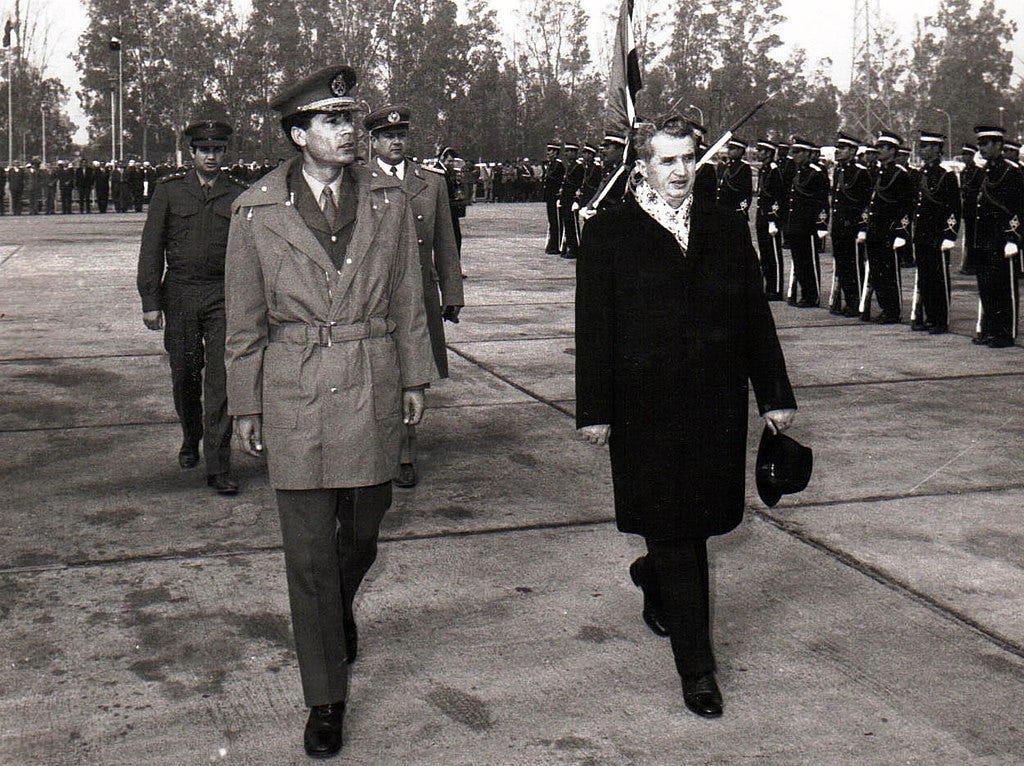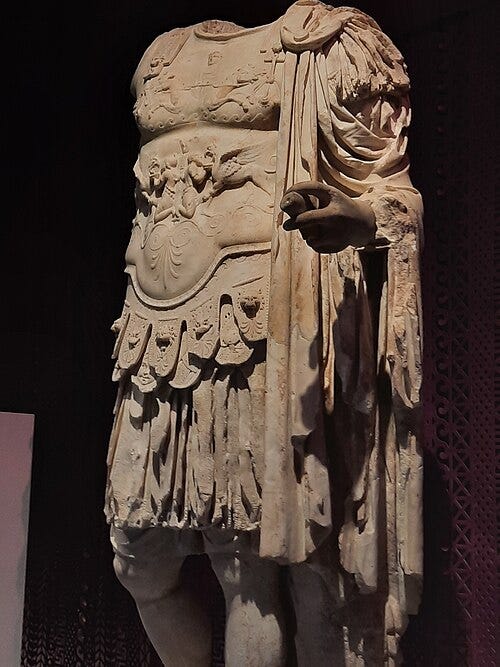Taking on the Tyrants
A new book, “How Tyrants Fall,” explains what keeps strongmen awake at night

Like Ernest Hemingway’s path to bankruptcy, a tyrant’s rule usually ends “gradually, then suddenly.” For more than 40 years, Muammar Qaddafi headed a ramshackle yet durable dictatorship in Libya via fear, bribes and selective violence. But when facing a mass insurrection in 2011, he found his old methods failed. Vowing to hunt down his enemies “alley by alley,” he provoked NATO’s military intervention, which overwhelmed his divided security forces. While attempting to flee his stronghold, Qaddafi was run down by the rebels, tortured and then shot. Sic semper tyrannis.
In his new book, “How Tyrants Fall,” German scholar Marcel Dirsus argues that tyrants like Qaddafi are fundamentally insecure. As Churchill once noted, they live in “unspoken fear.” Plato anticipated Dirsus’ argument 2,500 years ago. In “The Republic,” he claimed tyrants were motivated by fear and governed for their own personal gain, rather than the common good.
The illegitimacy of their rule requires tyrants to tend to their security constantly. They may seem to head durable regimes, but, in fact, their “stability is a mirage,” Dirsus believes: “Tyrants are often much weaker than they appear.” Leveraging this inherent psychological anxiety, Dirsus suggests, is the key to ending their rule. This may well be true, but the real test is whether Dirsus’ lesson applies to the four tyrants who disproportionally currently contribute to international disorder: Russia’s Vladimir Putin, China’s Xi Jinping, Iran’s Grand Ayatollah Khamenei and North Korea’s Kim Jong Un.
Dirsus’ book appears at a time of great pessimism about democracy, with some experts seeing dangerous backsliding. But the fear that democracy is losing ground to dictatorships is overstated. Last year, half the world's eligible population had the opportunity to vote in meaningful elections. Also last year, two longstanding dictators—à la Hemingway—rapidly fell from power: Syria’s Bashar al-Assad, whose security apparatus finally dissolved in the face of an armed rebellion, and Sheikh Hasina of Bangladesh, who quit the presidency after weeks of student revolts that her army refused to continue violently suppressing. Both dictators fled into exile: Assad to Russia and Hasina to India.
Indeed, the last several decades have seen an unprecedented growth of democracy. After World War II, 90% of the world’s regimes were some form of dictatorship. By 2012, fewer than 12% of governments were “closed” authoritarian regimes. The great democratic wave may have crested around 2017, but the democracies that did emerge since the 1970s have been remarkably durable. In 2022, about 50% of national governments were liberal or electoral democracies, according to two well-known experts. The global trend is still not working in the tyrants’ favor.
How Tyrants Survive
Dirsus sees the tyrant’s fall as practically inevitable. He focuses much of his account on tyrants in Africa. This is appropriate, as Freedom House in 2024 estimates only 7% of Africans live in free countries. Dirsus believes that tyrants who encourage a cult of personality are especially vulnerable. The good news is that 69% of personalist dictators end up either killed, jailed or exiled, Dirsus reports. Now the bad news: These downfalls often pave the way for another tyrant.
Some tyrants last for impressively long stretches. Authoritarians like Putin (in power since 2000) and Xi (since 2013) strut and fret upon the world stage, perhaps unloved, but certainly the objects of wary respect. Some, like North Korea’s Kim Jong Un (since 2011), are dynastic rulers. His father, Kim Jong Il, survived in power despite a 1990s famine so intense that his people had to eat tree bark to survive. But, according to the author, the perception that tyrants endure for decades may be an example of “survivorship bias”—that is, we focus on those rulers who succeed, not those who fail. On average, dictators stay in power only for 13 years, according to one expert.
Those tyrants that do manage to survive for a long time do so by coup-proofing their regimes, dividing up the security apparatus, micromanaging their lieutenants, controlling all decision-making, and combining force and fraud. Often, they draw key supporters from closely aligned ethnic groups like Iraq’s Saddam Hussein did with the Arab Tikriti subtribe he hailed from. Influenced by political scientist Bruce Bueno de Mesquita’s rational choice approach in “The Dictator’s Handbook,” Dirsus explains that dictators rely on a small circle of loyalists; as long as he can keep this select group content, usually through corruption, the tyrant is secure. Paradoxically, a lack of mutual trust in the circle prevents potential dissenters from breaking with the tyrant.
This approach also suffers major drawbacks. Instead of relying on competent ministers, tyrants lean on harmless mediocrities like Putin’s incompetent Defense Minister Sergei Shoigu, who finally was fired last year for bungling the Ukraine war for over two years. Also, being “surrounded by sycophants” means tyrants live in an echo chamber that makes it easier to make big mistakes. For example, former Chinese Communist Party member Cai Xia wrote in 2022 that President Xi’s growing personalist rule probably contributed to China’s disastrous response to the COVID-19 pandemic.
Assassination being a constant fear, tyrants go to extraordinary lengths to ensure their security. Saddam Hussein often moved from palace to palace, like a medieval monarch. Reportedly, Putin protects himself now by self-isolation. Kim Jong Un, Dirsus reports, has his nukes on autopilot to launch in case of assassination. Excessive security adds to their isolation and growing paranoia.
Dirsus argues that in depriving others of freedom, tyrants have often lost their own. Stepping down from power can be deadly. Succession stands out as a vulnerability because tyrants cannot cultivate a viable successor for fear of a power struggle. Likewise, if the retiring tyrant is at the mercy of the International Criminal Court, will he be inclined to give up power peacefully? Decades ago, skipping town was usually more of an option for failed dictators. For example, even though Ferdinand Marcos of the Philippines and Fulgencio Batista of Cuba lost the favor of Washington, they were still able to go into exile in the U.S. after losing power. But today, Dirsus tells us, dictators are six times less likely to decide on exile. So, we would do well to ensure they have a viable exit ramp.
One of the tyrant’s biggest assets is the general concern that his successor might even be worse. After Omar al-Bashir in Sudan was overthrown by a coup d’etat in 2019, for example, a military junta took over, and now civil war has broken out between rival factions. As already noted, the fall of a dictator usually results in a transition to democracy only about 20% of the time.
Hastening Their Demise
There’s no silver bullet to ending dictatorships, but they can fall in several ways. Tyrants can’t ignore masses of people in the streets. Dirsus cites the 3.5% rule, proposed by political scientist Erica Chenoweth, that if that percentage of the population takes to the streets to call for the dictator’s removal, the regime is often toast. In such cases, uncertainty in the face of a major challenge can doom the regime. In 1989, China’s Premier Deng Xiaoping at Tiananmen Square met the challenge, but Egypt’s President Hosni Mubarak and Ukraine’s Viktor Yanukovych both failed.
Unfortunately, “people power” only goes so far. As Venezuela’s tyrant Nicolas Maduro has shown, if the military sticks with the president, he can hunker down against all the protests in the world. Aiming to turn key regime loyalists might be a more profitable strategy. From 1950 to 2012, Dirsus tells us, 473 authoritarian leaders fell from power, with 65% of those removed by regime insiders, rather than popular pressure.
Losing a war sometimes settles the tyrant’s account. Argentina’s military junta in 1982 lost the Falklands War to the U.K., and by popular demand, democratic governance was soon restored. It remains to be seen whether such a fate eventually awaits Putin’s Russia.
Enticing some strongmen to choose the path of reform has some promise. As Tocqueville observed in one of the most enduring insights in social science, a bad government is most vulnerable when it sets about to reform itself. Several dictatorships, like those of South Korea’s Chun Doo-Hwan, Chile’s Augusto Pinochet and Mexico’s Carlos Salinas, put in motion reforms that led to lasting democratic transitions. But autocrats aren’t all created equal, and these types of reform efforts are quite rare.
Dirsus uses the word “tyrant” as a blanket descriptor for these authoritarian leaders. But should we lump Putin or Xi in with the Emir of Qatar? He admits that no two tyrants are alike. It would have been useful to categorize his tyrants into monarchical, personal, military and party-led, as these regime types seem to have different survival rates.
In some cases, outside military intervention might be required to end tyranny and force regime change, although the chance this will result in a democratic outcome is slim. Moreover, it is one thing to force out the Gambia’s Yahya Jammeh or Libya’s Qaddafi—rulers of weak countries—but what about the hardcore tyrannies in powerful states, like China, Russia, Iran and North Korea? Is it possible to crack their impressive rings of power?
Unfortunately, the author offers little guidance on how to tackle these more difficult challenges. But there are practical policies we can follow. Although Dirsus is skeptical of economic sanctions having much effect in undermining a regime, at least they make the tyrants’ lives more complicated. That’s because sanctions can inhibit tyrants’ ability to distribute cash and other perks to their followers, lessen their regime’s economic power and reach, and limit access to surveillance technology and weapons. Sanctions also allow us to increase the pressure on these regimes when they have made major blunders. Recently, Russia and Iran both miscalculated in starting wars, and they need to be seen as paying a heavy price for their mistakes.
Perhaps the most important weapon the world’s democracies have is their sense of optimism. Dirsus is right that time is on the free world’s side. Perhaps we can’t overthrow tyrants quickly and directly, but we can wear them down by thwarting their designs and increasing their burdens. By confidently promoting and exercising our democratic advantages, we can show their people a better alternative.





